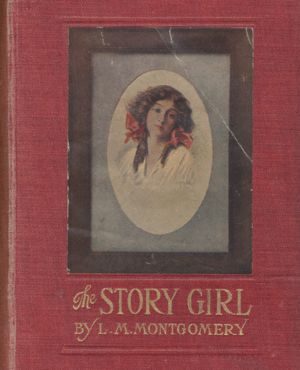The Story Girl facts for kids

First edition
|
|
| Author | Lucy Maud Montgomery |
|---|---|
| Country | Canada |
| Language | English |
| Genre | Children's novel |
|
Publication date
|
1911 |
| Media type | Print (Paperback, Hardcover) |
| Followed by | The Golden Road |
The Story Girl is a novel written in 1911 by the famous Canadian author L. M. Montgomery. It tells the exciting adventures of a group of young cousins and their friends. They live in a quiet countryside area on Prince Edward Island, Canada.
L. M. Montgomery once said that The Story Girl was her favorite book she had written up to that time.
Contents
What is The Story Girl About?
The book is told by a character named Beverley. He and his brother, Felix, go to live with their Aunt Janet and Uncle Alec King on their farm. Their father is away on a business trip.
The boys spend their free time with their cousins: Dan, Felicity, and Cecily King. They also hang out with Peter Craig, a boy who works on the farm, and their neighbor Sara Ray. Another cousin, Sara Stanley, is also part of the group. She is the "Story Girl" the book is named after. Sara Stanley loves to entertain everyone with amazing tales. These stories include many events from the King family's past.
The book is like two stories in one. It follows the adventures of Beverley King and his friends. But it also shares the many wonderful tales told by the Story Girl.
The Story Girl's Amazing Tales
L. M. Montgomery grew up in a Scottish-Canadian family. In her family, people often told stories, legends, and myths from Scotland. She used this background to create the character of Sara Stanley. Sara is very good at telling stories.
In the book, Sara Stanley is 14 years old. She is already a very skilled storyteller. Her stories are so good that they impress everyone. She can tell "witch stories" that will "freeze the blood in your veins." Sara is described as "gay and graceful." She has a dreamy quality, not just in her stories, but in herself. She once said, "I'd like a dress of moonshine with stars for buttons."
How the Author's Life Inspired the Book
When L. M. Montgomery wrote this novel, she was thinking a lot about her own teenage years. She used her personal diaries as inspiration for the book. This helped her create the lively world and characters.
Some characters in the book show different parts of Montgomery's own personality. For example, Sara Ray is a bit sad sometimes. This reflected how Montgomery herself sometimes felt. Also, the character of Felicity wants to get married when she grows up. This shows the author's own thoughts about being a writer versus getting married.
The book also talks about death in a light-hearted way. For example, the threat of death is sometimes just a sick cat or a case of measles. The Story Girl's tales often have serious parts. But the main story of the teenagers is usually presented in a fun way.
Types of Stories Sara Tells
The Story Girl tells 32 different stories throughout the book. These stories are very varied! Some are funny tales that make fun of serious people. Others are romantic stories from the "East." There are also Scottish folk tales and retellings of old Greek myths. Sara even tells "weird" ghost stories.
The novel ends in the beautiful autumn season. The trees are full of bright colors. The Story Girl stands with a garland made of leaves.
What Happens Next?
The sequel to The Story Girl is a book called The Golden Road. It was written in 1913.
The Story Girl was also one of the books that inspired the Canadian television series Road to Avonlea.

